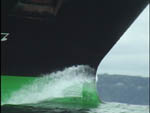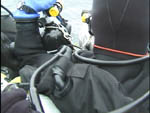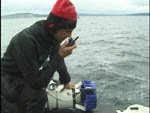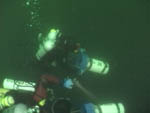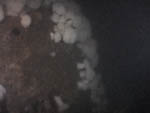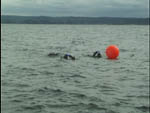 |

The S.S. Admiral Sampson | Historical archives | Underwater images/video | Exploration updates
April 2006:
We departed Everett around 8 am. Predicted slack was at 10 am. We set the "hook" on the first pass. Unfortunately, we found out later, it was about 50 feet from the wreck. Once hooked, we checked in with "Seattle Traffic", the Coast Guard controllers who monitor commercial traffic on the Puget Sound. They confirmed our approval to dive. As slack approached Uncle Fester, Kurt and I geared up and hit the water. Our safety divers, JoeRad and Bret E. were big help loading us up with multiple stage bottles, scooters and camera. We each carried two 80 stages and three smaller deco bottles.
We collected at the big Orange ball on the downline and started scootering straight down toward the wreck. Kurt had trouble with his sinuses and had to bail. Uncle Fester and I continued down. Somewhere past 200 ft. we hit the deep current that seems to run in Admiralty Inlet and the line made a sharp angle and we ran the last 100 feet or so almost parallel to the bottom. After a three minute descent, we arrived at the bottom at 315 ft. Small rocks everywhere and no wreck. We started scootering in ever larger circles around the downline looking.
Finally, at 10 min. we had a wall of white anemones in front of us - the hull. We scootered up to the top of the hull and onto the main deck. We were on the starboard side at about 300 feet. Visibility was good. We could see as far as Mark's 18 watt hid would penetrate the darkness. The video lights lit up the scene in front of us. The main deck appears to be collapsing down inside the hull and slopes up toward the bow. We followed the slope towards the bow and found the remains of the forward mast. At 12 min. Mark signaled that his first 80 stage was gone and it was time to change to 80 stage #2. We continued on, but missed the bow. We arched back toward the stern. We saw the biggest red snapper that we have ever seen (and Mark & I have been diving a long time). We scootered over a pile of plates that Kent Barnard had stacked on the deck during his salvage operation in the early 1990s. At 20 min., Mark signaled that it was time to end the dive and we began our ascent.
We had a comfortable drifting deco. JoeRad met us at our 120 ft. stop and helped unload excess gear and keep us company for the balance of the dive. He did a superb job. We also had great support from Captain Mike of Porthole Charters and our other support diver, Brett E.
Stay tuned. We return to the wreck on May 7. Afterward, we should have a really good collection of video footage from the wreck.
- posted by Walter Jaccard
We departed Mukilteo around 11 am. Predicted slack was not until 3:30 pm, but we wanted lots of time to "hook" the wreck, as we had no interest in scootering the bottom of Admiralty Inlet (been there, done that). Hooking a deep wreck in a high flow area is always a challenge. You guess how much to go upstream of the wreck, drop the hook and then drift back over the wreck, hoping the hook hits the bottom at the right time. It usually takes multiple attempts. We had brought Kevin Connell with us, however, who has an uncanny ability to guess these things, and were successful on our second attempt.
Once hooked, we checked in with "Seattle Traffic", the Coast Guard controllers who monitor commercial traffic on the Puget Sound. They confirmed our approval to dive. A short time later we had a deep-draft freighter bearing down on our buoy. We radioed the ship and asked them to avoid our buoy, as it would put us out of business if the ship took it out. The response was an angry tirade about us not belonging in the shipping lane, and they called Seattle Traffic to ask if our "paper work" was in order. Seattle Traffic confirmed that it was and instructed the freighter to turn to avoid us. About five minutes later, Seattle Traffic called the freighter again to tell them the Coast Guard was sending out a boat to do a routine safety inspection and that their paper work had better be in order when the Coast Guard arrived. After that incident, the commercial traffic was extremely cooperative.
As slack approached Uncle Fester and I geared up and hit the water. Our safety diver, Rich Brown, and surface support were big help loading us up with multiple stage bottles, scooters and camera. The surface water was calm as started scootering straight down toward the wreck. Somewhere past 200 ft. we hit the deep current that seems to run in Admiralty Inlet and the line made a sharp angle and we ran the last 100 feet almost parallel to the bottom.
After a four minute descent, we arrived at the wreck. We landed toward the aft end of the main section of the hull, at the top of the starboard side at about 300 feet. Visibility was good. We could see as far as Mark's 18 watt hid would penetrate the darkness. The video lights lit up the scene in front of us. We dropped down the hull to about 320 ft. to attempt to release our line, but the hook had dropped inside some debris and we weren't going to follow. There is enough current flowing around the outside of the hull that it is almost completely devoid of life. To get out of the current we dropped inside the hull onto the main deck. The main deck appears to be collapsing down inside the hull and slopes up toward the bow. The inside of the hull contains an incredible amount of life, including soft sponges and huge fish. We started toward the bow. Then, 14 minutes into the dive (for some reason known only to the gods of hid lights and e/o connectors), the video lights went out and it got very dark. We spent the next couple of minutes trying with no luck to cycles the lights and get them back on. This two minutes of video is actually kind of cool - it goes completely black and then you see parts of the wreck come and go as Mark's hid passes in front of the camera. Without lights, it was time to end the dive and start our ascent.
We had a comfortable drifting deco, although the currents were crazy. We experienced up and down wellings that moved us up or down 20 feet at a time and we were twirled in circles. Rich Brown met us at our 70 ft. stop and helped unload excess gear and keep us company for the balance of the dive. He did a superb job.
We also had great support from our surface crew, Kevin Connell and Kurt Kauth as well as the Porthole crew, Mike and Troy.
- posted by Walter Jaccard
Planning the dive:
We planned our dive with the current owner of the wreck, Argonaut Resources, Inc. (Kent Barnard and Gary Severson). Argonaut Resources located the Admiral Sampson in 1991 and, working through various state agencies and federal courts, secured exclusive salvage rights to the vessel in 1992.
With the help of local investors, Argonaut Resources financed several trips to the wreck and used a small submersible, ROVs and a Newt suit to recover artifacts and video the wreck. Both Kent Barnard and Gary Severson were excited to return to the wreck and see what we could accomplish.
Our dive also required approval from the US Coast Guard to conduct diving operations in the commercial VTS lane, and coordination by radio with the VTS controllers. May 11, 2000: We launched the boats at the Everett launch and headed out.
Our skippers fought rough water all the way around the south end of Whidbey Island. As we entered Admiralty Inlet, the ride got smoother. We did not have any trouble locating the wreck. However, we had to stop and move aside while a commercial freighter passed close to the site. We hooked the wreck and our surface support helped the mixed gas divers don doubles and stage bottles.
View all images from the dive »
The dive:
Our gavin scooters were handed to us as we hit the water and we started down. Initially the line went almost straight down. However, at 290 feet, we hit the bottom current and the line made a sharp angle and the last 100 feet was almost parallel to the bottom.
We hit the wreck at about 300 feet and tied in a reel. We headed up the wreck (we thought) fighting the current with the scooters. Visibility was 10 - 15 feet. We marveled at the amazing amount of life on the wreck. We came to an end of the wreck, and a quick glance at our bottom timers told us it was time to turn around and head back. This was an incredible dive.
The divers spent 20 minutes on the wreck at an average depth of 305 feet, followed by 100 minutes of decompression. The dive went flawlessly and the team returned with some great video footage. Review of this footage indicates that the divers were on the smaller stern section of the wreck and turned around at the actual stern. Further exploration is planned.
According to the owner of the wreck, Argonaut Resources, this is the first time scuba divers have visited the Admiral Sampson.
View all images from this dive »
The SCRET team consisted of:
• Mixed Gas Divers: Kevin Connell, Andrew Georgitsis (Video), Walter Jaccard, Brock Wheaton
•
Support Divers Mark Tourtellot, Miranda Alldritt
•
Boat Captains: Jay Jordan, Arron Pailthorpe
•
Surface Video: Gary Severson
•
Surface Support Kent Barnard, Sonya Tittle
- posted by Walter Jaccard

